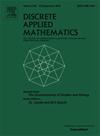Further results on injective edge coloring of graphs with maximum degree 5
IF 1
3区 数学
Q3 MATHEMATICS, APPLIED
引用次数: 0
Abstract
A graph is called injective -edge colorable if it has a -edge coloring such that any three consecutive edges , and in the same path or triangle satisfy . The injective chromatic index is the smallest such that is injective -edge colorable. We demonstrate that any graph with maximum degree 5 has at most 7 (resp. 8, 9, 10) if its maximum average degree is less than (resp. , , ), which improves some results of Zhu et al. (2023) and Bu et al. (2024).
最大次为5的图的内射边着色的进一步结果
如果图G具有k边着色φ,使得同一路径或三角形中的任意三条连续边e1,e2, e3满足φ(e1)≠φ(e3),则称图G为内射k边可着色。单射色指数χi ' (G)是最小的k,使得G是单射k边可着色的。我们证明了任何最大次为5的图的χi ' (G)最大为7。如果其最大平均度小于73,则为8,9,10。125, 52, 83),改进了Zhu et al.(2023)和Bu et al.(2024)的一些结果。
本文章由计算机程序翻译,如有差异,请以英文原文为准。
求助全文
约1分钟内获得全文
求助全文
来源期刊

Discrete Applied Mathematics
数学-应用数学
CiteScore
2.30
自引率
9.10%
发文量
422
审稿时长
4.5 months
期刊介绍:
The aim of Discrete Applied Mathematics is to bring together research papers in different areas of algorithmic and applicable discrete mathematics as well as applications of combinatorial mathematics to informatics and various areas of science and technology. Contributions presented to the journal can be research papers, short notes, surveys, and possibly research problems. The "Communications" section will be devoted to the fastest possible publication of recent research results that are checked and recommended for publication by a member of the Editorial Board. The journal will also publish a limited number of book announcements as well as proceedings of conferences. These proceedings will be fully refereed and adhere to the normal standards of the journal.
Potential authors are advised to view the journal and the open calls-for-papers of special issues before submitting their manuscripts. Only high-quality, original work that is within the scope of the journal or the targeted special issue will be considered.
 求助内容:
求助内容: 应助结果提醒方式:
应助结果提醒方式:


